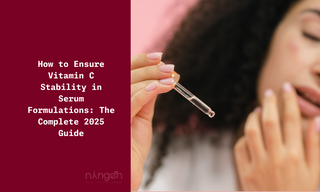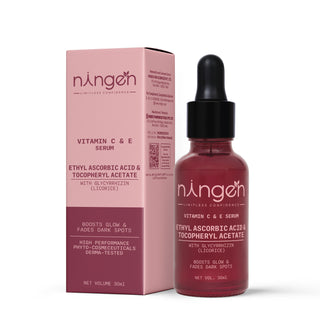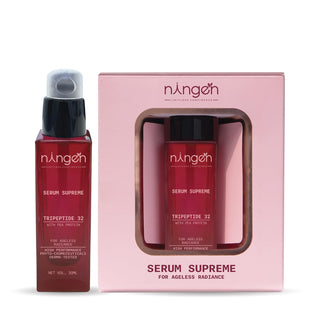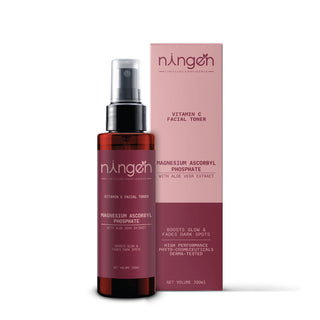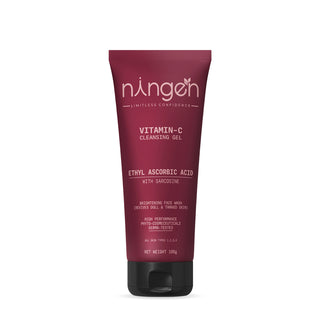Ever wondered why some vitamin C serums maintain their potency for months while others turn brown within weeks? The secret often lies in the choice of vitamin C derivative and how well it's formulated. Enter ethyl ascorbic acid (EAA) - the game-changing vitamin C derivative that's revolutionizing skincare formulations worldwide.
If you're a formulator, brand owner, or skincare enthusiast looking to understand the science behind stable vitamin C serums, you've landed in the right place. This comprehensive guide will walk you through everything you need to know about ensuring ethyl ascorbic acid (vitamin C) stability in serum formulations.
TLDR
Ethyl ascorbic acid offers 50x greater stability than L-ascorbic acid, making it the gold standard for vitamin C serums. Success requires maintaining a pH between 5.0 and 6.5, using a concentration of 0.5-5%, depending on the product type, and storing at a temperature below 25°C in dark conditions. Synergistic stabilizers like vitamin E, ferulic acid, and EDTA extend shelf life to 24-36 months, while proper water activity control prevents degradation. Unlike traditional vitamin C, ethyl ascorbic acid doesn't require refrigeration and maintains potency without the harsh acidity, making it ideal for stable, long-lasting formulations.
In this Guide;
What Makes Ethyl Ascorbic Acid Special?
Advanced Formulation Strategies
What Makes Ethyl Ascorbic Acid Special?
Ethyl ascorbic acid is a derivative of vitamin C that offers similar efficacy and improved stability in formulas, making it the holy grail for formulators who've struggled with traditional vitamin C's notorious instability.
Unlike its temperamental cousin L-ascorbic acid, ethyl ascorbic acid features an ethyl group attached to the 3-position of the ascorbic acid molecule. This seemingly small modification creates a molecular fortress that protects the vitamin C core from the three main enemies of stability:
-
Oxidation from air exposure
-
pH degradation in alkaline conditions
-
Heat-induced breakdown during storage

The Science Behind the Stability
The ethyl group acts as a protective shield, making EAA lipophilic enough to penetrate skin effectively while maintaining water solubility for easy formulation. It easily penetrates the stratum corneum of the skin and slowly releases vitamin C once absorbed, providing sustained benefits without the typical stability headaches.
Critical Stability Factors: The Foundation of Success
1. pH: The Make-or-Break Factor
pH range between 5-6.5 is critical for EAA stability. Here's why this narrow window matters:
pH Below 5.0:
-
Risk of skin irritation increases
-
Potential for over-exfoliation
-
May destabilize other active ingredients
pH Above 6.5:
-
EAA begins to degrade more rapidly
-
Reduced penetration efficiency
-
Compromised antioxidant activity
Pro Formulator Tip: Use a combination of citric acid and sodium citrate to create a robust buffering system that maintains pH stability throughout the product's shelf life.
2. Temperature Control: Keeping Cool Under Pressure
Temperature stability testing reveals EAA's impressive resilience:
-
Below 25°C (77°F): Excellent stability for 24+ months
-
25-30°C (77-86°F): Good stability for 18-24 months
-
Above 30°C (86°F): Accelerated degradation begins
Real-World Application: Always conduct accelerated stability testing at 40°C for 3 months to predict real-world performance. This simulates approximately 2 years of storage at room temperature.
3. Water Activity (aw): The Hidden Culprit
Water activity, not just water content, drives degradation reactions. Maintain aw below 0.85 for optimal stability:
-
Use glycols (propylene glycol, butylene glycol) to bind free water
-
Add humectants strategically - they're not just for skin benefits
-
Consider anhydrous formulations for maximum stability

Advanced Formulation Strategies: Beyond the Basics
Synergistic Stabilization System
The most stable EAA serums employ a multi-pronged approach:
Primary Stabilizers:
-
Tocopherol (Vitamin E): 0.1-0.5% - regenerates EAA from its oxidized form
-
Ferulic Acid: 0.1-0.2% - provides additional antioxidant protection
-
Chelating Agents: EDTA or phytic acid at 0.05-0.1% - binds trace metals that catalyze oxidation
Secondary Stabilizers:
-
Sodium Bisulfite: 0.01-0.05% - oxygen scavenger
-
BHT/BHA: 0.01-0.02% - lipophilic antioxidants for oil phases
-
Ascorbyl Palmitate: 0.1% - additional vitamin C synergy
The Goldilocks Concentration: Not Too Much, Not Too Little
Usage rate: 0.5 - 2% is the traditional recommendation, but modern formulations can go higher:
-
0.5-1%: Daily use serums, sensitive skin formulations
-
2-3%: Treatment serums, normal to oily skin
-
3-5%: Professional treatments, short-term use protocols
Concentration vs. Stability Relationship: Higher concentrations don't necessarily mean faster degradation, unlike L-ascorbic acid. EAA maintains stability even at 5% concentrations when properly formulated.
Manufacturing Best Practices: From Lab to Shelf
Production Environment Control
Atmospheric Conditions:
-
Nitrogen blanketing during mixing
-
Minimize air incorporation
-
Use vacuum processing when possible
-
Temperature-controlled environment (below 25°C)
Order of Addition Protocol:
-
Water phase: Purified water + humectants + pH adjusters
-
EAA dissolution: Add to water phase at room temperature
-
Oil phase: Prepare separately with oil-soluble stabilizers
-
Emulsification: Gradual addition with proper mixing
-
Final adjustments: pH, viscosity, additional actives
Quality Control Checkpoints
In-Process Testing:
-
pH monitoring every 15 minutes during production
-
Temperature logging throughout process
-
Visual inspection for color changes
-
Immediate potency testing
Finished Product Analysis:
-
HPLC assay for EAA content
-
pH verification
-
Microbiological testing
-
Accelerated stability initiation
Packaging: Your Formula's Armor
Container Selection Criteria
Primary Packaging Options:
Airless Pumps (Gold Standard):
-
Eliminates oxygen exposure
-
Prevents contamination
-
Consistent dosing
-
Extended shelf life
Amber Glass with Dropper:
-
UV protection
-
Inert material
-
Premium perception
-
Requires nitrogen headspace
Opaque Plastic Tubes:
-
Cost-effective
-
Travel-friendly
-
Good oxygen barrier (when properly selected)
-
Easy dispensing
Barrier Properties Assessment
Test your packaging with:
-
Oxygen transmission rate (OTR): <0.1 cc/package/day
-
Water vapor transmission rate (WVTR): <0.1 g/package/day
-
UV transmission: <1% for wavelengths 290-400nm
Storage and Handling: Maximizing Shelf Life
Optimal Storage Conditions
Manufacturing Storage:
-
Temperature: 15-25°C (59-77°F)
-
Humidity: <50% RH
-
Light: Dark conditions or amber glass
-
Air: Nitrogen blanketed when possible
Consumer Guidelines:
-
Refrigeration is optional but beneficial
-
Avoid bathroom storage (humidity fluctuations)
-
Keep away from direct sunlight
-
Use within 6-12 months after opening
Stability Indicators to Monitor
Visual Changes:
-
Color shift from clear to yellow/brown
-
Crystallization or precipitation
-
Phase separation in emulsions
Performance Changes:
-
pH drift outside target range
-
Viscosity changes >20%
-
Potency loss >10% from labeled amount
Common Formulation Pitfalls and Solutions
Problem #1: Unexpected Color Changes
Symptoms: Yellow to brown discoloration within weeks root causes:
-
Metal contamination (iron, copper)
-
pH drift above 6.5
-
Excessive heat exposure
-
Incompatible ingredients
Solutions:
-
Use chelating agents (EDTA, phytic acid)
-
Implement robust pH buffering
-
Review ingredient interactions
-
Improve temperature control
Problem #2: Crystallization Issues
Symptoms: Crystal formation, grittiness, phase separation root causes:
-
Concentration above solubility limit
-
Temperature fluctuations during storage
-
pH-induced solubility changes
-
Incompatible solvent system
Solutions:
-
Reduce concentration or improve solubilization
-
Add co-solvents (glycols, alcohols)
-
Stabilize pH more effectively
-
Use solubility enhancers
Problem #3: Potency Loss
Symptoms: Reduced efficacy over time, analytical assay decline root causes:
-
Oxidative degradation
-
Hydrolytic breakdown
-
Photo-degradation
-
Microbial contamination
Solutions:
-
Enhance antioxidant system
-
Improve packaging barrier properties
-
Add UV filters or opaque containers
-
Strengthen the preservation system
Testing and Validation: Proving Your Formula Works
Analytical Methods
HPLC Analysis (Gold Standard):
-
Quantitative EAA content
-
Degradation product identification
-
Purity assessment
-
Method validation required
Alternative Methods:
-
UV Spectrophotometry: Cost-effective for routine monitoring
-
Titration Methods: Simple but less specific
-
Colorimetric Assays: Rapid screening tools
Stability Testing Protocols
Accelerated Testing:
-
40°C/75% RH for 6 months
-
25°C/60% RH for 12 months
-
Real-time at intended storage conditions
Stress Testing:
-
Heat: 60°C for 2 weeks
-
Light: ICH photo-stability conditions
-
pH extremes: 3.0 and 8.0
-
Freeze-thaw cycles
Testing Schedule:
-
Initial (T0)
-
1, 2, 3, 6, 9, 12 months
-
Additional time points as needed

Regulatory Considerations: Staying Compliant
Global Regulatory Status
United States (FDA):
-
Generally Recognized as Safe (GRAS)
-
No specific concentration limits
-
Good Manufacturing Practices apply
European Union (SCCS):
-
Approved for cosmetic use
-
No specific restrictions
-
CPNP notification required
Asia-Pacific Markets:
-
Approved in most jurisdictions
-
Some countries require pre-market approval
-
Concentration limits may apply
Documentation Requirements
Technical Dossier Should Include:
-
Raw material specifications
-
Analytical methods and validation
-
Stability data
-
Safety assessment
-
Manufacturing process description
-
Quality control procedures
Future Trends and Innovations
Emerging Technologies
Encapsulation Systems:
-
Liposomal delivery
-
Nano-encapsulation
-
Cyclodextrin complexation
-
Smart release systems
Smart Packaging:
-
Oxygen indicators
-
Temperature-time integrators
-
Smart caps with preservation
-
Connected packaging for tracking
Formulation Innovations:
-
Anhydrous systems
-
Powder-to-serum technologies
-
Hybrid delivery systems
-
Personalized formulations
Sustainability Focus
Green Chemistry Approaches:
-
Bio-based stabilizers
-
Renewable packaging materials
-
Reduced water formulations
-
Biodegradable ingredients
Cost Optimization Strategies
Balancing Cost and Performance
High-Impact, Low-Cost Improvements:
-
Optimized pH buffering ($0.02-0.05 per unit)
-
Basic chelation system ($0.01-0.03 per unit)
-
Improved packaging selection ($0.10-0.50 per unit)
Medium Investment, High Return:
-
Advanced stabilizer systems ($0.05-0.15 per unit)
-
Premium packaging ($0.50-2.00 per unit)
-
Extended stability testing ($5,000-15,000 total)
Strategic Considerations:
-
Premium positioning justifies higher costs
-
Reduced returns/complaints offset formulation investment
-
Brand reputation protection is invaluable
Case Studies: Real-World Success Stories
Case Study 1: Startup Success
Challenge: Small skincare brand experiencing 40% product returns due to color changes
Solution Implemented:
-
Reformulated with EAA instead of L-ascorbic acid
-
Added chelating agent and improved pH buffering
-
Switched to airless packaging
-
Implemented proper stability testing
Results:
-
Returns reduced to <2%
-
Shelf life extended from 6 to 24 months
-
Customer satisfaction increased 85%
-
Cost per unit increased only 12%
Case Study 2: Enterprise Reformulation
Challenge: Major brand needed to replace unstable vitamin C formula across 12 SKUs
Solution Implemented:
-
Systematic EAA integration across product line
-
Unified stabilization platform
-
Enhanced packaging standards
-
Comprehensive stability database
Results:
-
Consistent 24+ month stability across all products
-
Reduced manufacturing complexity
-
30% reduction in quality complaints
-
Successful global market expansion
Troubleshooting Guide: Quick Problem Solvers
Rapid Diagnostic Checklist
Color Changes Appearing? ✓ Check pH (target: 5.0-6.5) ✓ Test for metal contamination ✓ Review storage temperature logs ✓ Assess packaging integrity
Crystals Forming? ✓ Verify concentration vs. solubility ✓ Check temperature history ✓ Review solvent system compatibility ✓ Consider co-solvent addition
Efficacy Declining? ✓ Analytical testing for potency ✓ UV exposure assessment ✓ Oxidation indicator evaluation ✓ Microbial contamination check
The Bottom Line: Your Path to EAA Success
Creating stable ethyl ascorbic acid serums comes down to mastering five key factors: maintaining pH between 5.0-6.5, implementing synergistic stabilization, choosing the right packaging, conducting thorough testing, and monitoring continuously. Ethyl ascorbic acid gives you a significant advantage over traditional L-ascorbic acid, offering superior stability and gentler formulation requirements.
Whether you're formulating your first vitamin C serum or optimizing an existing line, these principles will help you create products that maintain their potency and deliver consistent results. The future of vitamin C skincare is stable, effective, and bright - and now you know to formulate with confidence.
Found this guide helpful? We'd love to hear about your formulation experiences! Drop a comment below sharing your biggest EAA challenge or success story. What topics would you like us to cover next in our formulation series? Your feedback helps us create content that truly serves the cosmetic chemistry community.
Frequently Asked Questions
Q1. Is ethyl ascorbic acid better than L-ascorbic acid for serums?
Yes, ethyl ascorbic acid is significantly more stable than L-ascorbic acid in water-based formulations. Ethyl ascorbic acid is the most stable vitamin C derivative for skincare, offering 50x better stability while maintaining similar skin benefits. It's less likely to oxidize, doesn't require extremely low pH levels, and maintains potency for 24+ months when properly formulated.
Q2. What pH should ethyl ascorbic acid serums be formulated at?
pH range: between 5-6.5 is optimal for ethyl ascorbic acid stability and skin compatibility. This range ensures maximum ingredient stability while minimizing skin irritation. pH below 5.0 can irritate, while pH above 6.5 reduces stability and efficacy.
Q3. How much ethyl ascorbic acid should be used in serum formulations?
Usage rate: 0.5 - 2% is the standard recommendation, though concentrations up to 5% can be used effectively. For daily-use serums, 1-2% is ideal, while treatment serums can contain 3-5%. Higher concentrations don't necessarily provide better results and may increase irritation risk.
Q4. What ingredients help stabilize ethyl ascorbic acid in serums?
Key stabilizers include tocopherol (vitamin E) at 0.1-0.5%, ferulic acid at 0.1-0.2%, and chelating agents like EDTA at 0.05-0.1%. These create a synergistic system that prevents oxidation and extends shelf life significantly. Additional stabilizers like sodium bisulfite and BHT can provide extra protection.
Q5. How long do ethyl ascorbic acid serums stay stable?
Properly formulated ethyl ascorbic acid serums can maintain stability for 24-36 months when stored correctly. This is dramatically longer than L-ascorbic acid serums, which typically degrade within 6-12 months. Stability depends on formulation quality, packaging, and storage conditions.
Q6. What packaging is best for ethyl ascorbic acid serums?
Airless pump bottles provide the best protection by eliminating oxygen exposure. Amber glass bottles with droppers are also excellent, offering UV protection and inert storage. Both options should have low oxygen transmission rates (<0.1 cc/package/day) for optimal stability.
Q7. Can ethyl ascorbic acid serums be stored at room temperature?
Yes, unlike L-ascorbic acid serums, properly formulated ethyl ascorbic acid serums remain stable at room temperature (below 25°C/77°F). Refrigeration can extend shelf life but isn't necessary. Avoid storing in bathrooms or areas with temperature fluctuations.
Q8. Why do some ethyl ascorbic acid serums turn yellow or brown?
Color changes typically indicate metal contamination, pH drift above 6.5, excessive heat exposure, or formulation issues. Proper use of chelating agents, pH buffering, and quality control during manufacturing prevents these problems. High-quality EAA serums should remain clear throughout their shelf life.
Q9. Is ethyl ascorbic acid safe for sensitive skin?
Yes, ethyl ascorbic acid is generally gentler than L-ascorbic acid because it can be formulated at higher, less irritating pH levels (5.0-6.5 vs. 3.0-3.5). Start with lower concentrations (0.5-1%) and patch test before full use. It's suitable for most skin types, including sensitive skin.
Q10. How can you test ethyl ascorbic acid serum stability at home?
Look for visual changes (color shifts, crystallization), check pH with test strips (should remain 5.0-6.5), and monitor viscosity changes. Professional HPLC testing provides accurate potency measurements, but home users can assess basic stability through visual inspection and pH monitoring over time.
Sources and Further Reading:
Disclaimer: This information is for educational purposes only. Always consult with qualified cosmetic chemists and conduct proper testing before bringing products to market. Regulatory requirements may vary by jurisdiction.


